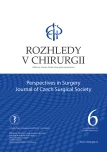Systemic toxic effects of Mesocain® in routine surgical practice upon iatrogenic overdose requiring cardiopulmonary resuscitation – case report
Authors:
J. Šimek 1,3; K. Šmejkal 1,3; M. Jakl 2; J. Trlica 1,3
Authors‘ workplace:
Katedra vojenské chirurgie, Fakulta vojenského zdravotnictví Hradec Králové, Univerzita obrany v Brně, Česká republika
1; Klinika anesteziologie, resuscitace a intenzivní medicíny, Fakultní nemocnice Hradec Králové, Česká republika
2; Chirurgická klinika, Fakultní nemocnice Hradec Králové, Česká republika
3
Published in:
Rozhl. Chir., 2023, roč. 102, č. 6, s. 257-260.
Category:
Case Reports
doi:
https://doi.org/10.33699/PIS.2023.102.6.257–260
Overview
This case report of a patient with a traumatic head injury provides an example of a systemic toxic reaction to a local anesthetic. Clinical signs of a systemic toxic reaction and hemorrhagic shock may initially be similar: tachycardia, hypotension and unconsciousness. The purpose is thus to remind that even the treatment of a minor injury can develop into a life-threatening condition. When a skin wound is treated using suture under local or regional anesthesia, the annual incidence rate of systemic toxic reactions is 1 : 3,000 and that of death is 1 : 30,000.
Keywords:
anaphylaxis – mesocain – trimecain – toxic reaction
Sources
- ATLS Subcommittee; American College of Surgeons’ Committee on Trauma; International ATLS working group. Advanced Trauma Life Support (ATLS®). the 8th edition. J Trauma Acute Care Surg. 2013 May;74(5):1363–1366. doi: 10.1097/ TA.0b013e31828b82f5.
- Chiu WC, Cushing BM, Rodriguez A, et al. Abdominal injuries without hemoperitoneum: a potential limitation of focused abdominal sonography for trauma (FAST). J Trauma 1997;42(4):617–623. doi: 10.1097/00005373-199704000-00006.
- Holmdahl MH. Xylocain (lidocaine, lignocaine), its discovery and Gordh’s contribution to its clinical use. Acta Anaesthesiol Scand Suppl. 1998;113 : 8–12. doi: 10.1111/j.1399-6576.1998.tb04979.x.
- Verlinde M, Hollmann MW, Stevens MF, et al. Local anesthetic-induced neurotoxicity. Int J Mol Sci. 2016;17(3):339. doi: 10.3390/ijms17030339.
- Pichler WJ, Adam J, Daubner B, et al. Drug hypersensitivity reactions: pathomechanism and clinical symptoms. Med Clin North Am. 2010 Jul;94(4):645–664, xv. doi: 10.1016/j.mcna.2010.04.003.
- Brockow K, Garvey LH, Aberer W, et al. Skin test concentrations for systemically administered drugs – an ENDA/EAACI Drug Allergy Interest Group position paper. Allergy 2013;68(6):702–712. doi: 10.1111/all.12126.
- Simons FER, Ardusso LRF, Bilò MB, et al. World Allergy Organization anaphylaxis guidelines: summary. J Allergy Clin Immunol. 2011;127(3):587–593. doi: 10.1016/j.jaci.2011.01.038.
- Coombs RRA, Gell PGH. Classification of allergic reactions responsible for drug hypersensitivity reactions. In: Clinical aspects of immunology. Oxford, Blackwell, Philadelphia 1963 : 575–596.
- Waldinger R, Weinberg G, Gitman M. Local anesthetic toxicity in the geriatric population. Drugs Aging 2020;37(1). doi: 10.1007/s40266-019-00718-0.
- Wadlund DL. Local anesthetic systemic toxicity. AORN J 2017;106(5):367–377. doi: 10.1016/j.aorn.2017.08.015.
- Ring J, Beyer K, Biedermann T, et al. Guideline (S2k) on acute therapy and management of anaphylaxis. 2021 Update. Allergo J Int. 2021;30(1):1–25. doi: 10.1007/s40629-020-00158-y.
- Simons FE, Ardusso LR, Bilò MB, et al. World Allergy Organization. 2012 Update: World Allergy Organization guidelines for the assessment and management of anaphylaxis. Curr Opin Allergy Clin Immunol. 2012 Aug 12(4):389–99. doi: 10.1097/ACI.0b013e328355b7e4.
- Soar J, Perkins GD, Abbas G. European Resuscitation Council guidelines for resuscitation 2010 Section 8. doi: 10.1016/j. resuscitation.2010.08.015.
- Turner PJ, Gowland MH, Sharma V, et al. Increase in anaphylaxis-related hospitalizations but no increase in fatalities: an analysis of United Kingdom national anaphylaxis data, 1992-2012. J Allergy Clin Immunol. 2015;135(4):956–963.e1. doi: 10.1016/j.jaci.2014.10.021.
- Sekimoto K, Tobe M, Saito S. Local anesthetic toxicity: acute and chronic management. Acute Med Surg. 2017;4(2):152–160. doi: 10.1002/ams2.265.
- Hine LK, Laird N, Hewitt P, et al. Meta-analytic evidence against prophylactic use of lidocaine in acute myocardial infarction. Arch Intern Med. 1989;149(12):2694–2698. doi:10.1001/ archinte.1989.00390120056011.
- Zhu B, Zhou X, Zhou Q, et al. Intra-venous lidocaine to relieve neuropathic pain: A systematic review and meta-analysis. Front Neurol 2019; 10 : 954. doi: 10.3389/ fneur.2019.00954.
- Stark BJ, Sullivan TJ. Biphasic and protracted anaphylaxis. J Allergy Clin Immunol. 1986;78(1 Pt 1):76–83. doi: 10.1016/0091-6749(86)90117-x.
- Ring J, Beyer K, Biedermann T, et al. Leitlinie zu Akuttherapie und Management der Anaphylaxie Update 2021. Allergo J. 2021;30(1):20–49. doi: 10.1007/ s15007-020-4750-0.
- Adamus M, Cvachovec K, Černý V. Doporučený postup pro léčbu anafylaktické nebo anafylaktoidní reakce v průběhu anesteziologické péče. ČSARIM 2013. Available at: https://www.csarim.cz/getmedia/780a- 7a6a-b8d9-4891-877c-e48043a73eed/doporuceny-postup-pro-lecbu-anafylakticke-nebo-anafylaktoidni-reakce-v-prubehu-anesteziologicke-pece-2013.pdf.aspx.
- Cvachovec K, Černý V, Doležal D. Doporučení pro léčbu toxické reakce po podání lokálních anestetik. ČSARIM, 2012, Available at: https://www.csarim.cz/ getmedia/fab99007-ab30-4d0e-bb2a-9b425135b9a6/doporuceni-pro-lecbu-toxicke-reakce-po-podani-lokalnich-anestetik-2012.pdf.aspx.
Labels
Surgery Orthopaedics Trauma surgeryArticle was published in
Perspectives in Surgery

2023 Issue 6
Most read in this issue
- Systemic toxic effects of Mesocain® in routine surgical practice upon iatrogenic overdose requiring cardiopulmonary resuscitation – case report
- Blast syndrome – pathophysiology, diagnosis and treatment of blast injuries
- Acute mesenteric ischemia – a persistent problem
- Strangulation ileus caused by malposition of the ureter
